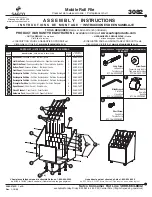
10
Range of motion and flexibility
This device can be used for both upper and lower body. As a lower body device, it
works with passive motion to increase tone of the quadriceps muscles (muscles in the
thigh) and circulate blood flow to the entire lower leg and foot. For upper body use, it is
used as a resistance device, allowing the user to exercise the muscles of the arm (biceps,
triceps, deltoids and the smaller muscles of the forearms).
Routine
People vary in how they adapt to repetitive exercise. In developing an exercise routine,
pay attention to how you feel, especially after an exercise is completed. You may feel
tired but you should not feel exhausted. When you first start exercising, the principal
muscles you use will ache slightly, especially the next day. However, they should not hurt
to cramp. No matter what the recommended exercise routine, never exercise beyond
the point of discomfort.
For the first two weeks, you should begin with 5-10 minutes once a day at a low speed.
After the first two weeks, you can increase the time on the device to 15-20 minutes as
you become more accustomed to the exercise. The speed can also be increased once
you have adapted to the device. Longer periods of exercise will result in greater gains.
Leg Exercise
Place the Pedal Exerciser on a non-slip mat and
sit comfortably in a chair, the device directly
in front of you. The knee joint should not be
flexed less than 90 degrees. Wear rubber soled
shoes and adjust foot pedal straps to the proper
length. Barefooted use of the Pedal Exerciser is
not recommended.
WARNING
Do not stand on the unit to exercise. Only
exercise in a seated position. Make sure the seat
does not move or pivot. Do not sit in a chair
with casters.
NOTE: Use the foot pedals
(17/18) for leg exercises.
Workout


























